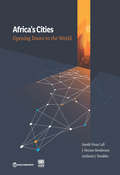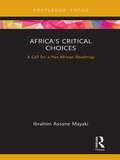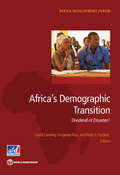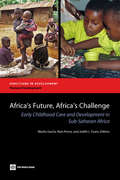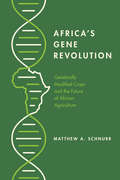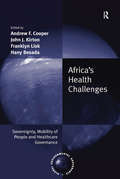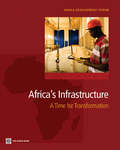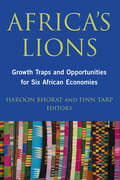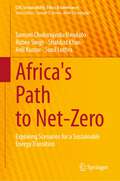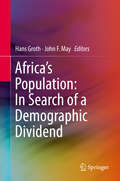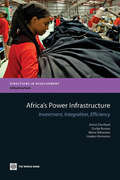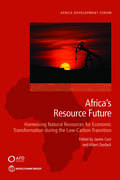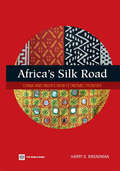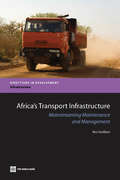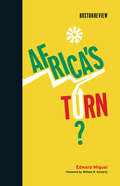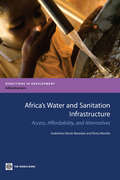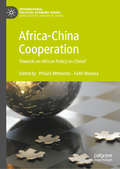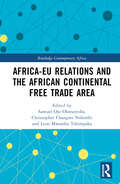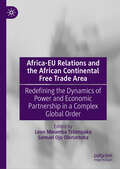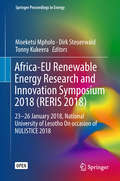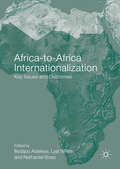- Table View
- List View
Africa's Cities: Opening Doors to the World
by Anthony J. Venables J. Vernon Henderson Somik Vinay LallCities in Sub-Saharan Africa are experiencing rapid population growth. Yet their economic growth has not kept pace. Why? One factor might be low capital investment, due in part to Africa’s relative poverty: Other regions have reached similar stages of urbanization at higher per capita GDP. This study, however, identifies a deeper reason: African cities are closed to the world. Compared with other developing cities, cities in Africa produce few goods and services for trade on regional and international markets To grow economically as they are growing in size, Africa’s cities must open their doors to the world. They need to specialize in manufacturing, along with other regionally and globally tradable goods and services. And to attract global investment in tradables production, cities must develop scale economies, which are associated with successful urban economic development in other regions. Such scale economies can arise in Africa, and they will—if city and country leaders make concerted efforts to bring agglomeration effects to urban areas. Today, potential urban investors and entrepreneurs look at Africa and see crowded, disconnected, and costly cities. Such cities inspire low expectations for the scale of urban production and for returns on invested capital. How can these cities become economically dense—not merely crowded? How can they acquire efficient connections? And how can they draw firms and skilled workers with a more affordable, livable urban environment? From a policy standpoint, the answer must be to address the structural problems affecting African cities. Foremost among these problems are institutional and regulatory constraints that misallocate land and labor, fragment physical development, and limit productivity. As long as African cities lack functioning land markets and regulations and early, coordinated infrastructure investments, they will remain local cities: closed to regional and global markets, trapped into producing only locally traded goods and services, and limited in their economic growth.
Africa's Critical Choices: A Call for a Pan-African Roadmap (Europa Regional Perspectives)
by Dunod EditeurThis volume examines contemporary Africa, a vast continent which, while entering the era of globalization, is also confronted by a number of issues, including the environment and climate change, demographics, trade issues, internal and external migration, education, economic Issues, governance, and the influence of other countries. Written by former Prime Minister of Niger and current Chief Executive Officer of the Secretariat of the New Partnership for Africa’s Development (NEPAD), Dr Ibrahim Assane Mayaki, this book offers an overview of Africa, and looks to the next generation of leaders in the continent, aiming to offer a manifesto for future change.
Africa's Demographic Transition
by David Canning Abdo S. Yazbeck Sangeeta RajaAfrica is poised on the edge of a potential takeoff to sustained economic growth. This takeoff can be abetted by a demographic dividend from the changes in population age structure. Declines in child mortality, followed by declines in fertility, produce a 'bulge' generation and a large number of working age people, giving a boost to the economy. In the short run lower fertility leads to lower youth dependency rates and greater female labor force participation outside the home. Smaller family sizes also mean more resources to invest in the health and education per child boosting worker productivity. In the long run increased life spans from health improvements mean that this large, high-earning cohort will also want to save for retirement, creating higher savings and investments, leading to further productivity gains. Two things are required for the demographic dividend to generate an African economic takeoff. The first is to speed up the fertility decline that is currently slow or stalled in many countries. The second is economic policies that take advantage of the opportunity offered by demography. While demographic change can produce more, and high quality, workers, this potential workforce needs to be productively employed if Africa is to reap the dividend. However, once underway, the relationship between demographic change and human development works in both directions, creating a virtuous cycle that can accelerate fertility decline, social development, and economic growth. Empirical evidence points to three key factors for speeding the fertility transition: child health, female education, and women's empowerment, particularly through access to family planning. Harnessing the dividend requires job creation for the large youth cohorts entering working age, and encouraging foreign investment until domestic savings and investment increase. The appropriate mix of policies in each country depends on their stage of the demographic transition.
Africa's Development in Historical Perspective
by James A. Robinson Robert H. Bates Emmanuel Akyeampong Robert H. Bates Nathan Nunn Emmanuel Akyeampong Nathan NunnThis edited volume addresses the root causes of Africa's persistent poverty through an investigation of its longue durée history. It interrogates the African past through disease and demography, institutions and governance, African economies and the impact of the export slave trade, colonialism, Africa in the world economy, and culture's influence on accumulation and investment. Several of the chapters take a comparative perspective, placing Africa's developments aside other global patterns. The readership for this book spans from the informed lay reader with an interest in Africa, academics and undergraduate and graduate students, policy makers, and those in the development world.
Africa's Future, Africa's Challenge: Early Childhood Care and Development in Sub-saharan Africa
by Marito H. Garcia Alan Pence Judith EvansEarly childhood, from birth through school entry, was largely invisible worldwide as a policy concern for much of the twentieth century. Children, in the eyes of most countries, were 'appendages' of their parents or simply embedded in the larger family structure. The child did not emerge as a separate social entity until school age (typically six or seven). 'Africa's Future, Africa's Challenge: Early Childhood Care and Development in Sub-Saharan Africa' focuses on the 130 million children south of the Sahel in this 0-6 age group. This book, the first of its kind, presents a balanced collection of articles written by African and non-African authors ranging from field practitioners to academicians and from members of government organizations to those of nongovernmental and local organizations. 'Africa's Future, Africa's Challenge' compiles the latest data and viewpoints on the state of Sub-Saharan Africa's children. Topics covered include the rationale for investing in young children, policy trends in early childhood development (ECD), historical perspectives of ECD in Sub-Saharan Africa including indigenous approaches, new threats from HIV/AIDS, and the importance of fathers in children's lives. The book also addresses policy development and ECD implementation issues; presents the ECD programming experience in several countries, highlighting best practices and challenges; and evaluates the impact of ECD programs in a number of countries.
Africa's Gene Revolution: Genetically Modified Crops and the Future of African Agriculture
by Matthew A. SchnurrAs development donors invest hundreds of millions of dollars into improved crops designed to alleviate poverty and hunger, Africa has emerged as the final frontier in the global debate over agricultural biotechnology. The first data-driven assessment of the ecological, social, and political factors that shape our understanding of genetic modification, Africa's Gene Revolution surveys twenty years of efforts to use genomics-based breeding to enhance yields and livelihoods for African farmers. Matthew Schnurr considers the full range of biotechnologies currently in commercial use and those in development – including hybrids, marker-assisted breeding, tissue culture, and genetic engineering. Drawing on interviews with biotechnology experts alongside research conducted with more than two hundred farmers across eastern, western, and southern Africa, Schnurr reveals a profound incongruity between the optimistic rhetoric that accompanies genetic modification technology and the realities of the smallholder farmers who are its intended beneficiaries. Through the lens of political ecology, this book demonstrates that the current emphasis on improved seeds discounts the geographic, social, ecological, and economic contexts in which the producers of these crops operate. Bringing the voices of farmers to the foreground of this polarizing debate, Africa's Gene Revolution contends that meaningful change will come from a reconfiguration not only of the plant's genome, but of the entire agricultural system.
Africa's Gene Revolution: Genetically Modified Crops and the Future of African Agriculture
by Matthew A. SchnurrAs development donors invest hundreds of millions of dollars into improved crops designed to alleviate poverty and hunger, Africa has emerged as the final frontier in the global debate over agricultural biotechnology. The first data-driven assessment of the ecological, social, and political factors that shape our understanding of genetic modification, Africa's Gene Revolution surveys twenty years of efforts to use genomics-based breeding to enhance yields and livelihoods for African farmers. Matthew Schnurr considers the full range of biotechnologies currently in commercial use and those in development - including hybrids, marker-assisted breeding, tissue culture, and genetic engineering. Drawing on interviews with biotechnology experts alongside research conducted with more than two hundred farmers across eastern, western, and southern Africa, Schnurr reveals a profound incongruity between the optimistic rhetoric that accompanies genetic modification technology and the realities of the smallholder farmers who are its intended beneficiaries. Through the lens of political ecology, this book demonstrates that the current emphasis on improved seeds discounts the geographic, social, ecological, and economic contexts in which the producers of these crops operate. Bringing the voices of farmers to the foreground of this polarizing debate, Africa's Gene Revolution contends that meaningful change will come from a reconfiguration not only of the plant's genome, but of the entire agricultural system.
Africa's Health Challenges: Sovereignty, Mobility of People and Healthcare Governance (Global Environmental Governance)
by Hany Besada Andrew F. Cooper John J. Kirton Franklyn LiskThis volume addresses the ideational and policy-oriented challenges of Africa’s health governance due to voluntary and involuntary cross-border migration of people and diseases in a growing 'mobile Africa'. The collected set of specialized contributions in this volume examines how national and regional policy innovation can address the competing conception of sovereignty in dealing with Africa’s emerging healthcare problems in a fast-paced, interconnect world.
Africa's Infrastructure: A Time for Transformation
by World BankSustainable infrastructure development is vital for Africa's prosperity. And now is the time to begin the transformation. This volume is the culmination of an unprecedented effort to document, analyze, and interpret the full extent of the challenge in developing Sub-Saharan Africa's infrastructure sectors. As a result, it represents the most comprehensive reference currently available on infrastructure in the region. The book covers the five main economic infrastructure sectors-information and communication technology, irrigation, power, transport, and water and sanitation. 'Africa's Infrastructure: A Time for Transformation' reflects the collaboration of a wide array of African regional institutions and development partners under the auspices of the Infrastructure Consortium for Africa. It presents the findings of the Africa Infrastructure Country Diagnostic (AICD), a project launched following a commitment in 2005 by the international community (after the G8 summit at Gleneagles, Scotland) to scale up financial support for infrastructure development in Africa. The lack of reliable information in this area made it difficult to evaluate the success of past interventions, prioritize current allocations, and provide benchmarks for measuring future progress, hence the need for the AICD. Africa's infrastructure sectors lag well behind those of the rest of the world, and the gap is widening. Some of the main-policy-relevant-findings highlighted in the book include the following: infrastructure in the region is exceptionally expensive, with tariffs being many times higher than those found elsewhere. Inadequate and expensive infrastructure is retarding growth by 2 percentage points each year. Solving the problem will cost over US$90 billion per year, which is more than twice what is being spent in Africa today. However, money alone is not the answer. Prudent policies, wise management, and sound maintenance can improve efficiency, thereby stretching the infrastructure dollar. There is the potential to recover an additional US$17 billion a year from within the existing infrastructure resource envelope-simply by improving efficiency. For example, improved revenue collection and utility management could generate US$3.3 billion per year. Regional power trade could reduce annual costs by US$2 billion. And deregulating the trucking industry could reduce freight costs by one-half. So, raising more funds without also tackling inefficiencies would be like pouring water into a leaking bucket. Finally, the power sector and fragile states represent particular challenges. Even if every efficiency in every infrastructure sector could be captured, a substantial funding gap of $31 billion a year would remain. Nevertheless, the African people and economies cannot wait any longer. Now is the time to begin the transformation to sustainable development.
Africa's Lions: Growth Traps and Opportunities for Six African Economies
by Finn Tarp Haroon BhoratExamining the economic forces that will shape Africa's future.Africa's Lions examines the economic growth experiences of six fast growing and/or economically dominant African countries. Expert African researchers offer unique perspectives into the challenges and issues in Ethiopia, Ghana, Kenya, Mozambique, Nigeria, and South Africa.Despite a growing body of research on African economies, very little has focused on the relationship between economic growth and employment outcomes at the detailed country level. A lack of empirical data has deprived policymakers of a robust evidence base on which to make informed decisions. By harnessing country-level household, firm, and national accounts data together with existing analytical country research-the authors have attempted to bridge this gap.The growth of the global working-age population to 2030 will be driven primarily by Africa, which means that the relationship between growth and employment should be understood within the context of each country's projected demographic challenge and the associated implications for employment growth. A better understanding of the structure of each country's workforce and the resulting implications for human capital development, the vulnerably employed, and the working poor, will be critical to informing the development policy agenda.As a group, the six countries profiled in Africa's Lions will largely shape the continent's future. Each country chapter focuses on the complex interactions between economic growth and employment outcomes, within the individual Africa's Lions context.
Africa's Oil Abundance and External Competitiveness: Do Institutions Matter?1
by Mahvash Saeed QureshiFinancial report from the IMF
Africa's Path to Net-Zero: Exploring Scenarios for a Sustainable Energy Transition (CSR, Sustainability, Ethics & Governance)
by Shahbaz Khan Anil Kumar Sunil Luthra Samuel Chukwujindu Nwokolo Rubee SinghThis book provides a comprehensive analysis of the challenges and opportunities for achieving a net-zero energy transition in Africa. With a focus on policy, technology, financing, and socio-political factors, the book presents four potential scenarios for a sustainable energy transition in the continent. The scenarios presented highlight the importance of balancing economic growth with environmental sustainability and social development. While foreign investments in renewable energy could be beneficial, they must be carefully monitored and regulated to prevent exploitation and ensure accountability. The book also emphasizes the need for collaboration and a calculated transition to ensure that all stakeholders are involved in the process. Additionally, the challenges of achieving self-sufficiency and export-free energy are discussed, with the importance of setting limitations and regulations to prevent a vicious cycle of poverty and dependency on foreign aid. With a deep understanding of Africa's environmental, socio-political, and socio-cultural complexities, “Africa's Path to Net-Zero” offers valuable insights for policymakers, investors, and anyone interested in promoting a sustainable energy future for the continent.
Africa's Population: In Search of a Demographic Dividend
by John F. May Hans GrothThis book examines the promises as well as the challenges the demographic dividend brings to sub-Saharan Africa as fertility rates in the region fall and the labor force grows. It offers a detailed analysis of what conditions must be met in order for the region to take full economic advantage of ongoing population dynamics. As the book makes clear, the region will need to accelerate reforms to cope with its demographic transition, in particular the decline of fertility. The continent will need to foster human capital formation through renewed efforts in the areas of education, health and employment. This will entail a true vision and determination on the part of African leaders and their development partners. The book will help readers to gain solid knowledge of the demographic trends and provide insights into socioeconomic policies that eventually might lead sub-Saharan Africa into a successful future.
Africa's Power Infrastructure
by Anton Eberhard Orvika Rosnes Maria Shkaratan Haakon VennemoAfrica's chronic power problems have escalated in recent years into a crisis affecting 30 countries, taking a heavy toll on economic growth and productivity. The region has inadequate generation capacity, limited electrification, low power consumption, unreliable services, and high costs. It also faces a power sector financing gap on the order of $21 billion a year. It spends only about a quarter of what it needs to spend on power, much of this on operating expenditure required to run the continent's high-cost power systems, leaving little for the huge investments needed to provide a long-term solution. Further development of regional power trade would allow Africa to harness larger scale more cost-effective energy sources, reducing energy system costs by $2 billion a year and saving 70 million tons of carbon emissions annually. Economic returns to investments in cross-border transmission are particularly high. But reaping the promise of regional trade depends on a handful of major exporting countries raising the large volumes of finance needed to develop generation capacity for export. It would also require political will in a large number of importing countries that could potentially meet more than half their power demand through trade. Power sector inefficiencies are high, deterring investment in new capacity and electrification. There are three types of sector inefficiencies. First, there are utility inefficiencies, which include system losses, under-collection of revenue and over-manning. These result in a major waste of resources adding up to $4.40 billion a year. Under-collection is the largest component of utility inefficiencies amounting to $1.73 billion, following by system losses at $1.48 billion and by over-manning at $1.15 billion. The second type of sector inefficiency is under-pricing of power. By setting tariffs below the levels needed to cover the actual costs, SSA countries forego revenues of $3.62 billion a year. The third type of inefficiency is poor budget execution. Only 66% of the capital budgets allocated to power are actually spent, with about $258 million in public investment earmarked for the power sector being diverted elsewhere in the budget. Full cost recovery tariffs would already be affordable in countries with efficient large scale hydro or coal-based systems, but not in those relying on small scale oil-based plants. Once regional power trade comes into play, generation costs will fall, and full cost recovery tariffs could be affordable in much of Africa. One of the key policy challenges is to strengthen sector planning capabilities, too often overlooked in today's hybrid markets. A serious recommitment to reforming state-owned enterprises should emphasize improvements in corporate governance more than purely technical fixes. Improving cost recovery is essential for sustaining investments in electrification and regional power generation projects. Closing the huge financing gap will require improving the creditworthiness of utilities and sustaining the recent upswing in external finance to the sector This book is based on extensive data collection undertaken between 2006 and 2008 by the Africa Country Infrastructure Country Diagnostic, an initiative of the Infrastructure Consortium for Africa delegated to the World Bank under the guidance of the African Union, African Development Bank and other multi-lateral and bilateral development institutions.
Africa's Resource Future: Harnessing Natural Resources for Economic Transformation during the Low-Carbon Transition (Africa Development Forum)
by James Cust and Albert ZeufackThis book examines the role for natural resource wealth in driving Africa’s economic transformation and the implications of the low-carbon transition for resource-rich economies. Resource wealth remains central to most Sub-Saharan African economies, and significant untapped potential is in the ground. Subsoil assets—such as metals, minerals, oil, and gas—are key sources of government revenues, export earnings, and development potential in most countries in the Africa region. Despite large reserves, success in converting subsoil wealth into aboveground sustainable prosperity has been limited. Since the decline in commodity prices in 2014, resource-rich Africa has grown more slowly than the region’s average growth rate. Finding ways to more effectively harness natural resource wealth to drive economic transformation will be central to Africa’s economic future. As the world moves away from fossil fuels in alignment with commitments under the Paris Agreement, Africa’s resource-rich countries face new risks and opportunities. Recent estimates suggest that 80 percent of the world’s proven fossil fuel reserves must remain underground to meet the Paris targets, and much of these stranded reserves may be in Africa. This issue of stranded assets and, relatedly, “stranded nations,†? has major implications for the many African economies that are dependent on petroleum extraction and export. On the other hand, the energy transition will increase demand for raw material inputs involved in clean energy technologies. The transition from fossil fuels to clean energy may create demand by 2050 for 3 billion tons of minerals and metals that are needed to deploy solar, wind, and geothermal energy. How can African economies tap into these opportunities while managing the downside risk to their fossil fuel wealth? Africa’s Resource Future explores these themes and offers policy makers insights to help them navigate the coming years of uncertainty.
Africa's Silk Road: China and India's New Economic Frontier
by Harry G. BroadmanChina and India's new-found interest in trade and investment with Africa - home to 300 million of the globe's poorest people and the world's most formidable development challenge - presents a significant opportunity for growth and integration of the Sub-Saharan continent into the global economy. Africa's Silk Road finds that China and India's South-South commerce with Africa is about far more than natural resources, opening the way for Africa to become a processor of commodities and a competitive supplier of goods and services to these countries - a major departure from its long established relations with the North. A growing number of Chinese and Indian businesses active in Africa operate on a global scale, work with world-class technologies, produce products and services according to the most demanding standards, and foster the integration of African businesses into advanced markets.There are significant imbalances, however, in these emerging commercial relationships. These can be addressed through a series of reforms in all countries: 'At-the-border' reforms, such as elimination of China and India's escalating tariffs on Africa's leading exports, and elimination of Africa's tariffs on certain inputs that make exports uncompetitive 'Behind-the-border' reforms in Africa, to unleash competitive market forces and strengthen its basic market institutions 'Between-the-border' improvements in trade facilitation mechanisms to decrease transactions costs Reforms that leverage linkages between investment and trade, to allow African businesses to participate in global production networks that investments by Chinese and Indian firms can generate.
Africa's Trade Revisited
by Arvind Subramanian Natalia TamirisaThe popular impression that Africa has not integrated into world trade, as suggested by the evolution in simple indicators, has been callled into question recently by more formal analysis. This paper refines and generalizes this analysis, but lends supports to the popular view of disintegration. Africa, especially francophone Africa, is currently under-exploiting its trading opportunities and has witnessed disintegration over time, a trend that is most pronunced in its trade with the technologically advanced countries.
Africa's Transport Infrastructure
by Kenneth GwilliamThis book presents and analyzes the results of a comprehensive collection of data on the extent and condition of transport infrastructure in Sub-Saharan Africa, identifies the reasons for poor performance, and estimates future financing needs. The transport facilities of Sub-Saharan Africa were built primarily for the colonial exploitation of mineral and agricultural resources. The chief goal of road and rail networks was to link mines, plantations, and other sites for the exploitation and transformation on natural resources to ports, rather than to provide general connectivity within the region. The road network of 1.75 million kilometers exhibits a low density with respect to population. Its average spatial density is very low by world standards. The network carries low average traffic levels. Even so, because most African countries have a low GDP, the fiscal burden of the network is the highest among world regions, maintenance is underfinanced, and road conditions are on average poor, while road accident rates are very high. Attempts to improve the financing of maintenance through "second generation road funds" have met with some success, but there remain serious weaknesses in implementation. Road freight transport is fragmented, but cartelized, with high rates and high profits. Railways were also built mainly as for the exportation of minerals and crops. With the exception of two or three very specialized bulk mineral lines, the traffic volumes are low, and the railways have been in financial decline since the 1960s. Concessioning of the lines to private operators has improved performance, but governments often impose unachievable requirements on the companies, and investment remains inadequate for long-term sustainability. Most of the 260 airports that provide year-round commercial service in Sub-Saharan Africa have adequate runway capacity, though some of the larger airports suffer from a shortage of terminal capacity. More than a quarter of the runways are in marginal or poor condition, and air traffic control and navigation facilities are below international standards. Though airport charges are high, few airports are truly financially sustainable. Three national carriers are quite successful, but most are small and barely sustainable. Protection persists in the domestic and intercontinental markets, but the international market in the region has been effectively liberalized. The safety record is poor. Most ports are small by international standards. Many are still publicly owned and suffer from inadequate equipment and poor productivity. Only a few highly specialized ports, including private ports integrated with the extraction companies, meet the highest international standards Costs and charges are high. But there is a trend toward concessioning of facilities to large groups specializing in international container terminals and port operations. Fortunately the shipping market is now deregulated. Urban transport suffers from some infrastructure deficiencies, particularly in the condition of urban roads. But the main problems of the sector are associated with the fragmented and poorly regulated nature of most urban bus markets. Finance for large buses is very difficult to obtain. In all modes the situation is made worse by failures of governance in both the provision and regulation of infrastructure. The overall deficit in financing for infrastructure is estimated using a model based on the application of hypothesized standards of connectivity for all modal networks and facilities. Once the amount of infrastructure needed to meet those standards was calculated, these "requirements" were compared with existing stocks and the costs of making the transition over a ten-year period were calculated. A "base" scenario used standards similar to those pertaining in developed regions, while a "pragmatic" scenario applied lower standards. In a separate exercise, the actual average expenditures on transport infrastructure from all sources were researched. This allowed the funding gap to be deduced by subtraction....
Africa's Turn? (Boston Review Books)
by Edward MiguelSigns of hope in sub-Saharan Africa: modest but steady economic growth and the spread of democracy.By the end of the twentieth century, sub-Saharan Africa had experienced twenty-five years of economic and political disaster. While “economic miracles” in China and India raised hundreds of millions from extreme poverty, Africa seemed to have been overtaken by violent conflict and mass destitution, and ranked lowest in the world in just about every economic and social indicator. Working in Busia, a small Kenyan border town, economist Edward Miguel began to notice something different starting in 1997: modest but steady economic progress, with new construction projects, flower markets, shops, and ubiquitous cell phones. In Africa's Turn? Miguel tracks a decade of comparably hopeful economic trends throughout sub-Saharan Africa and suggests that we may be seeing a turnaround. He bases his hopes on a range of recent changes: democracy is finally taking root in many countries; China's successes have fueled large-scale investment in Africa; and rising commodity prices have helped as well. Miguel warns, though, that the growth is fragile. Violence and climate change could derail it quickly, and he argues for specific international assistance when drought and civil strife loom. Responding to Miguel, nine experts gauge his optimism. Some question the progress of democracy in Africa or are more skeptical about China's constructive impact, while others think that Miguel has underestimated the threats represented by climate change and population growth. But most agree that something new is happening, and that policy innovations in health, education, agriculture, and government accountability are the key to Africa's future.ContributorsOlu Ajakaiye, Ken Banks, Robert Bates, Paul Collier, Rachel Glennerster, Rosamond Naylor, Smita Singh, David N. Weil, and Jeremy M. Weinstein
Africa's Water and Sanitation Infrastructure
by Sudeshna Ghosh Banerjee Elvira MorellaThe welfare implications of safe water and sanitation cannot be overstated. The economic gains from provision of improved services to millions of unserved Africans in enormous. The international adoption of Millennium Development Goals brought the inadequacies of service provision sharply into focus. With only 58% and 31% enjoying access to water and sanitation services respectively, Sub-Saharan Africa is the only continent that is off-track in achieving the MDGs in 2015. The problem is compounded by the fact that a rigorous and credible baseline did not exist on coverage to improved water and sanitation and resources required to meet the MDGs. This book aims to contribute to this gap by collecting a wealth of primary and secondary information to present the most up-to-date and comprehensive quantitative snapshot of water and sanitation sectors. The book evaluates the challenges to the water and sanitation sectors within the urban and rural areas and deepen our understanding of drivers of coverage expansion in the context of financing, institutional reforms, and efficiency improvements. Finally, the book establishes the investment needs for water and sanitation with a target of meeting the MDGs and compares with the existing financing envelopes, disaggregated by proportions that can be recouped by efficiency gains and net financing gaps. The directions for the future draw on lessons learned from best practices and present the menu of choices available to African countries. There is no recipe book that neatly lays out the possible steps the country should adopt to enhance coverage and quality of service. The challenges differ to a significant extent among African countries and solutions must be tailored to individual national or regional conditions.
Africa-China Cooperation: Towards an African Policy on China? (International Political Economy Series)
by Philani Mthembu Faith MaberaThis book offers a range of perspectives on the Africa–China partnership in the context of the Forum on China and Africa Cooperation (FOCAC). Incorporating historical, political, social and cultural dimensions, it offers innovative views on the Africa–China relationship that combine theory and practice, and critically examines the prospects of a Pan-African policy towards China, complementary to China’s comprehensive African policy. The chapters address a number of key questions, including: What steps are being taken to achieve a more coordinated approach and policy towards China on the African continent? Does Africa even need a collective strategy in the first place? How would a coherent policy framework affect Africa’s relations with Europe and other external partners? How do the pillars of the partnership align with the African Union’s Agenda 2063 and the United Nation’s 2030 Agenda for Sustainable Development?
Africa-EU Relations and the African Continental Free Trade Area (Routledge Contemporary Africa)
by Samuel Ojo Oloruntoba, Christopher Changwe Nshimbi and Leon Mwamba TshimpakaThis book explores relations between states in the Africa–European Union in view of the African Continental Free Trade Area, both at a regional level and as a series of informal processes of socioeconomic and political interactions between state and non-state actors. The book reconsiders the ways in which actors in the Africa–European Union relationship function, and what that means for regionalism, regionalisation and regional integration. In addition to formalised state-to-state and inter-regional interactions, the book examines the impact of socio-economic and political interactions with non-state actors, including those who engage with regional integration through formal and informal processes such as civil society activists, “African migration evangelists”, human smugglers and human traffickers. The book thus demonstrates that regional and inter-regional engagements include issues that extend beyond the usual discussions of trade. The book is authored from an African perspective and will be of interest to academics who specialise in International Relations, Political Economy, Political Sociology and African Studies. Policy makers and various actors in civil society and think tanks who have an academic inclination and deal with trade, migration and regionalism in Africa and Africa’s relations with Europe will also find the book beneficial.
Africa-EU Relations and the African Continental Free Trade Area: Redefining the Dynamics of Power and Economic Partnership in a Complex Global Order
by Samuel Ojo Oloruntoba Leon Mwamba TshimpakaThis book examines the establishment and implementation of the AfCFTA, which is the largest free trade area globally, covering 54 African countries. It explores how this initiative has the potential to reshape Africa-EU relations by promoting intra-African trade, economic integration, and diversification, as well as inter- regional trade. Both continents have potential to serve as global actors in reshaping the global order in ways that can affect how multilateralism foster inclusive development. However, whether this will happen would be a function of how the EU and AU define their interests and relationship.
Africa-EU Renewable Energy Research and Innovation Symposium 2018: 23–26 January 2018, National University of Lesotho On occasion of NULISTICE 2018 (Springer Proceedings in Energy)
by Moeketsi Mpholo Dirk Steuerwald Tonny KukeeraThis open access book presents the proceedings of the 2nd Africa-EU Renewable Energy Research and Innovation Symposium (RERIS 18), held in Maseru, Lesotho in January 2018. The symposium aimed to foster research cooperation on renewable energy between Africa and Europe – in academia, as well as the private and public sectors. Addressing thematic areas such as• Grid-connected renewable energy;• Decentralised renewable and household energy solutions;• Energy socioeconomics; and• Promotion of energy research, innovation, education and entrepreneurship,the book brings together contributions from academics and practitioners from the EU and Africa to enable mutual learning and knowledge transfer – a key factor in boosting sustainable development in the African renewable energy market. It also plays a significant role in promoting African renewable energy research, which helps to secure energy supply in both rural and urban areas and to increase generation capacities and energy system resilience. This book is an invaluable resource for academics and professionals across the renewable energy spectrum.
Africa-to-Africa Internationalization: Key Issues and Outcomes (AIB Sub-Saharan Africa (SSA) Series)
by Ifedapo Adeleye Lyal White Nathaniel BosoHighlighting an important emerging trend in FDI to Africa, thisbook consists of important contributions focusing on an increase in trade andinvestment between African countries. An area that until now has receivedlittle attention, this volume aims to define the key issues and explores thechallenges and outcomes that have characterized Africa-to-Africainternationalization, providing guidance on directions for future research. Africa-to-Africa Internationalizationincludes both conceptual and empirical contributions, illustrating thepractical issues in intra-African trade and investment. Providing readers witha deep sense of the realities and challenges of cross-border investments withinthe region, the cases included in the book are useful pedagogical materials forfaculty members interested in teaching international business in the Africancontext.
